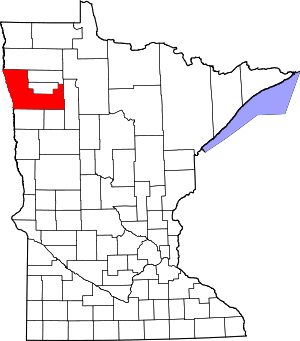Helgeland Township, Polk County, Minnesota
Helgeland Township is a township in Polk County, Minnesota, United States. It is part of the Grand Forks-ND-MN Metropolitan Statistical Area. The population was 52 at the 2000 census.
Helgeland Township, Minnesota | |
|---|---|
 Helgeland Township, Minnesota Location within the state of Minnesota | |
| Coordinates: 48°8′42″N 96°35′15″W | |
| Country | United States |
| State | Minnesota |
| County | Polk |
| Area | |
| • Total | 27.1 sq mi (70.1 km2) |
| • Land | 27.1 sq mi (70.1 km2) |
| • Water | 0.0 sq mi (0.0 km2) |
| Elevation | 945 ft (288 m) |
| Population (2000) | |
| • Total | 52 |
| • Density | 1.9/sq mi (0.7/km2) |
| Time zone | UTC-6 (Central (CST)) |
| • Summer (DST) | UTC-5 (CDT) |
| FIPS code | 27-28358[1] |
| GNIS feature ID | 0664445[2] |
Geography
According to the United States Census Bureau, the township has a total area of 27.1 square miles (70 km2), all of it land.
Demographics
At the 2000 census there were 52 people in 18 households, including 16 families, in the township. The population density was 1.9 people per square mile (0.7/km²). There were 20 housing units at an average density of 0.7/sq mi (0.3/km²). The racial makeup of the township was 100.00% White.[1] Of the 18 households 33.3% had children under the age of 18 living with them, 77.8% were married couples living together, 11.1% had a female householder with no husband present, and 11.1% were non-families. 11.1% of households were one person and none had someone living alone who was 65 or older. The average household size was 2.89 and the average family size was 3.13.
The age distribution was 28.8% under the age of 18, 5.8% from 18 to 24, 25.0% from 25 to 44, 21.2% from 45 to 64, and 19.2% 65 or older. The median age was 42 years. For every 100 females, there were 108.0 males. For every 100 females age 18 and over, there were 117.6 males.
The median household income was $43,750 and the median family income was $40,000. Males had a median income of $41,667 versus $16,750 for females. The per capita income for the township was $14,768. None of the population or the families were below the poverty line.
References
- "U.S. Census website". United States Census Bureau. Retrieved 2008-01-31.
- "US Board on Geographic Names". United States Geological Survey. 2007-10-25. Retrieved 2008-01-31.
- Upham, Warren (1920). Minnesota Geographic Names: Their Origin and Historic Significance. Minnesota Historical Society. p. 425.
